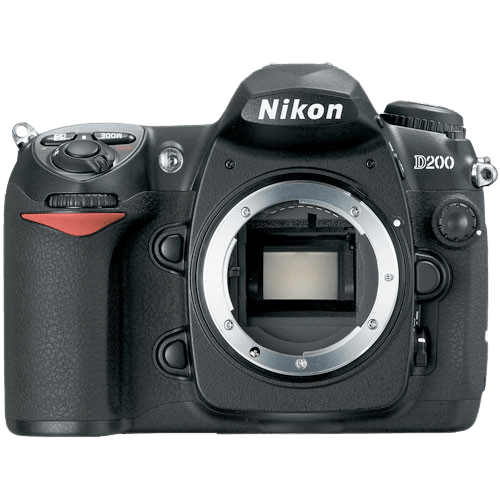Nikon D200 Specs and Scores

The Nikon D200 receives a score of 37/100 for its general specifications. Launched in 2005 with a price of $1000, this DSLR camera measures 147 x 113 x 74mm and weighs 920g or 2.03lbs. Considering the advancements in the market since its release, the D200’s specifications may not be as competitive today. However, for those seeking a budget-friendly option, this camera still offers solid features and performance.
Nikon D200 Overview and Optics
The Nikon D200’s optics score is 41 out of 100, which reflects its capabilities in comparison to other cameras in today’s market. The camera has a 10-megapixel resolution, a shooting speed of 5 frames per second, and a CCD sensor type. Additionally, it features a Nikon image processing engine and a DXOMARK sensor score of 64.
The Nikon D200 has an APS-C sensor size and utilizes a Nikon F DX lens mount. However, it lacks image stabilization, which could impact image quality in certain shooting situations. The camera’s aspect ratio is 3:2, which is standard for most DSLR cameras.
Considering these specifications, the Nikon D200 shows limitations in its optics capabilities compared to current camera models. While it may suffice for basic photography needs, it falls short in offering advanced features and performance that many photographers seek in today’s competitive market.
Nikon D200 Video Performance
The Nikon D200 lacks video capabilities. However, it has built-in time-lapse functionality.
Nikon D200 Features and Benefits
The Nikon D200 receives a feature score of 30/100. This score reflects its 2.5-inch screen size and 230,000-dot screen resolution. The camera lacks modern features such as a touchscreen, flip screen, GPS, WIFI, and Bluetooth capabilities.
In today’s market, the D200’s specifications fall short compared to newer models. The absence of a touchscreen and flip screen limits its versatility for shooting from different angles and quick navigation through settings. Additionally, the lack of GPS, WIFI, and Bluetooth hinders the camera’s connectivity, making it less convenient for sharing and transferring photos.
The Nikon D200, with its limited features and dated specifications, struggles to compete in the current market. Its lower score reflects its inability to meet the demands of modern photographers who seek advanced technology and seamless connectivity in their equipment.
Nikon D200 Storage and Battery
The Nikon D200 storage and battery score is 35/100, reflecting its limitations in these areas. The camera has only one memory card slot and accepts Compact Flash (Type I or II) cards. In today’s market, many cameras offer multiple memory card slots and support for SD cards, which are more widely available and affordable than Compact Flash cards.
Regarding the battery, the D200 provides 800 shots per charge using the EN-EL3e battery. Although this number is respectable, it falls behind the performance of some contemporary cameras that offer longer battery life. Additionally, the absence of USB charging in the D200 is a disadvantage as it limits the charging options for users.
Taking these factors into account, the Nikon D200’s storage and battery capabilities do not excel when compared to more recent camera models. Despite its strengths in other areas, potential buyers should consider the storage and battery aspects before purchasing this camera.
